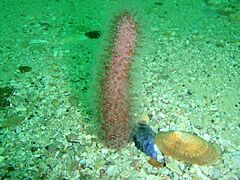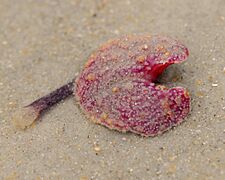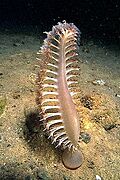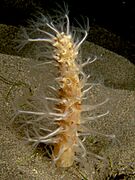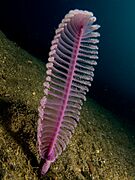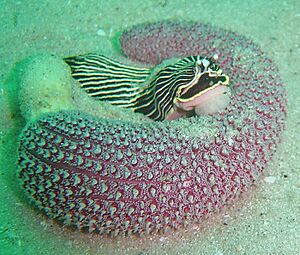Sea pen facts for kids
Quick facts for kids Sea pen |
|
|---|---|
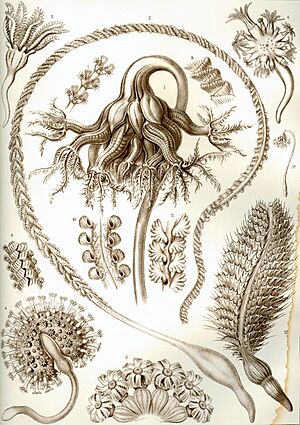 |
|
| "Pennatulida" from Ernst Haeckel's Kunstformen der Natur, 1904 | |
| Scientific classification |
|
| Unrecognized taxon (fix): | Pennatulacea |
| Family | |
|
see text |
|
Sea pens are amazing marine creatures. They are a type of cnidarian, like jellyfish and sea anemones. Sea pens belong to a group called Pennatulacea. These animals live in groups, forming a colony. They attach themselves to the seafloor and filter tiny food from the water.
There are many different kinds of sea pens. Scientists have found about 450 types, but around 200 of these are truly unique species. You can find sea pens all over the world. They live in warm tropical waters and cooler areas too. They can be found in shallow waters near the shore or in the deep sea, more than 6,100 meters (20,000 feet) deep!
Sea pens are related to sea whips, which are also called gorgonians. The name "sea pen" comes from how some of them look like old-fashioned quill pens. But not all sea pens look like that! Some are more club-shaped or spread out. These are often called sea pansies. The oldest known sea pen fossils are from the Cambrian period. This means they have been around for a very long time!
Contents
Different Types of Sea Pens
Scientists group sea pens into different families. Here are some of the main families:
- Chunellidae
- Echinoptilidae
- Renillidae
- Scleroptilidae
- Stachyptilidae
- Suborder Sessiliflorae
- Anthoptilidae
- Funiculinidae
- Kophobelemnidae
- Protoptilidae
- Pseudumbellulidae
- Umbellulidae
- Veretillidae
- Suborder Subsessiliflorae
- Halipteridae
- Pennatulidae
- Virgulariidae
How Sea Pens Live
Sea pens are made up of many small parts called polyps. Each polyp looks a bit like a tiny sea anemone with eight tentacles. But in a sea pen colony, these polyps have special jobs.
One polyp grows into a tall, stiff stalk. This stalk is called the rachis. It has a bulb-like "root" at its bottom, called a peduncle. Other polyps grow out from this main stalk. Some polyps bring water into the colony. Others have stinging cells called nematocysts to catch food. And some polyps are for reproduction. The whole colony is made strong by tiny calcium carbonate pieces called spicules.
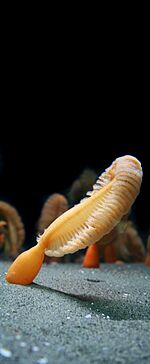
Sea pens use their root-like peduncles to anchor themselves in sand or mud. The part of the sea pen that sticks out of the seafloor can be very tall. Some species, like the tall sea pen, can grow up to 2 meters (6.5 feet) high! Sea pens can be very colorful. The orange sea pen is a great example.
They usually live in deeper waters, below 10 meters (33 feet). This is because strong currents in shallow water could pull them out of the sand. Some sea pens live in very deep water, even more than 2,000 meters (6,500 feet) down.
Movement and Defense
Even though sea pens usually stay in one spot, they can move if they need to. They can pull up their roots and re-anchor themselves in a better place. They like to position themselves where water currents bring them lots of plankton, which is their main food.
Sea pens have a few enemies, mostly nudibranchs (sea slugs) and sea stars. Some of these predators eat only sea pens. When a sea pen is touched, some types can make a bright greenish light. This is called bioluminescence. They can also squirt water out of their bodies. This makes them deflate quickly and pull back into the sand for protection.
Reproduction and Life Cycle
Like other anthozoans, sea pens reproduce by releasing sperm and eggs into the water. This can happen at certain times of the year or all year long. When an egg is fertilized, it grows into a tiny larva called a planula. This larva floats freely for about a week. Then, it settles down on the seafloor and grows into a new sea pen colony.
Older sea pens can provide shelter for other animals, like young fish. Scientists think that sea pens can live for a very long time. Some might even live for 100 years or more!
Sea Pens in Aquariums
Sometimes, sea pens are sold for home aquariums. However, they are generally hard to take care of. They need a very deep sandy bottom to anchor themselves. They also have special food needs that can be difficult to provide.


